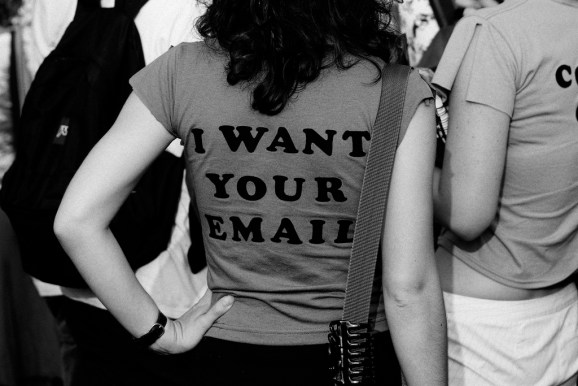

Everyone hates email. It wastes our time, too much of it is spam, it’s a to-do list that strangers can write on, it’s ugly, it’s slow, it’s unreliable. And did I mention the spam?
Perhaps the worst thing about email is the way it makes us unlikeable. I’m a reasonably nice person, as anyone who has met me face to face can probably tell you. But when I start sending emails, watch out. What I think is a perfectly ordinary, level headed email often comes across to other people as demanding or insensitive. (To say nothing of my autoreplies — those drive my coworkers up the wall.)
It’s not just me — I’ve seen people get enraged at each other over a seemingly innocuous intra-office email thread that suddenly escalates like an international border incident. But when those people get together face to face, the anger and the tension dissipate in minutes. The problem in these situations is clear: It’s the way email enforces a kind of formality, combined with lack of nuance. The combination can be toxic.
No wonder people are fleeing to messaging apps like WhatsApp, Facebook Messenger, Snapchat, Kik, and beyond. And on the enterprise side, no wonder Slack’s business is booming: If you can get your internal company communications off email and onto a fun platform that encourages productivity, shareability, and searchability — while supporting GIFs and emoji — it’s a win for everyone.
Yes, there’s no doubt about it: Email is an unholy hack, a broken mess, an ever-growing floating island of garbage and dead fish swirling around in some forgotten part of the ocean. It needs to die, and the sooner the better.
And yet.
Let’s just imagine a future without email — maybe just a few years hence, when these messaging apps are widespread enough that you could legitimately say “I’m deleting my email account” and not be seen as strange or experimental. And, more importantly, when you could do that and still be confident that the right people could reach you, whether that’s by Twitter DM or Facebook or Slack.
First of all, none of the messaging apps have anywhere near the market penetration and reach of email, which reaches 2.5 billion people today, according to the Radicati Group. So you’ll probably need to keep a few messaging apps: Facebook Messenger for your friends using that, Snapchat for your other group of friends, Slack for work, and so on.
Second, these messaging apps all have their own ways of doing things, so each one has its own rules and its own interface. Lest you think that’s a small problem, just look at how often people mistakenly send private direct messages to all their Twitter followers. Even the CFO of Twitter made that mistake, and who can blame him? It’s ridiculously easy to do this. So you need to use extra caution with Twitter, WhatsApp, Snapchat, and whichever apps you’re using, to ensure that you are using each one the right way, and not committing some horribly embarrassing (or business-threatening) mistake.
Third, they’re not interoperable. Each messaging app has its own separate platform, its own notifications on my mobile devices, its own list of my friends. You can’t send a message from Messenger to your friend on KakaoTalk, and you never will be able to. There’s no incentive for these companies to open up their message platforms to all comers.
Fourth, these platforms often lack fundamental features that are actually quite useful. Slack, for instance, still doesn’t have threaded messages. If you don’t reply to someone’s post super quick, you might as well forget about it, because someone else is going to start another conversation and then no one will know what you’re replying to. (I know there is a workaround, but it’s kludgey.) Or how about filters and folders? It’s often quite useful to filter messages from a certain person — your boss, for example — into a special high-priority folder, where you can give it special attention, or save it along with all the other messages that person sent.
Fifth: Spam. You may not have noticed it, but if you’re a Gmail user, outright spam is getting rarer and rarer in your inbox, thanks to ever-more sophisticated spam filtering. Google has spent more than a decade honing its spam algorithms, and the result works pretty darn well. Twitter, by contrast: If you missed the old days of X10 camera spam and offers for green card lawyers, just turn on the setting that lets anyone send you a DM even if you’re not following them. Google’s spam mechanism has the equivalent of a Ph.D., while Twitter’s is still in kindergarten.
Finally, there’s one more angle to consider: Email, from a marketer’s point of view, actually works, with an ROI of 38 to 1, according to one estimate (.pdf). There’s a reason that Twitter and Slack, despite being their own messaging platforms, still send daily emails to people. For many Internet users, email is still the way they’d prefer to be contacted, and companies are happy to oblige, because engagement levels are so much higher than in other media.
And email marketing companies are thriving — Campaign Monitor, to name one example, raised $250 million last year.
Now, you could argue that this is exactly the problem: Too much email marketing is making email useful only for marketing. But I think the reason email marketing works so effectively is because, at the end of the day, people are still very attached to their inboxes.
We may complain about email. We may suffer from crappy email clients and all-company email threads that never end. Our inboxes may never get close to zero.
But if the current crop of messaging apps really did succeed in killing off email, I think we would all start to miss it pretty soon.
Originally published on VentureBeat » Dylan Tweney: http://ift.tt/1T93smx
